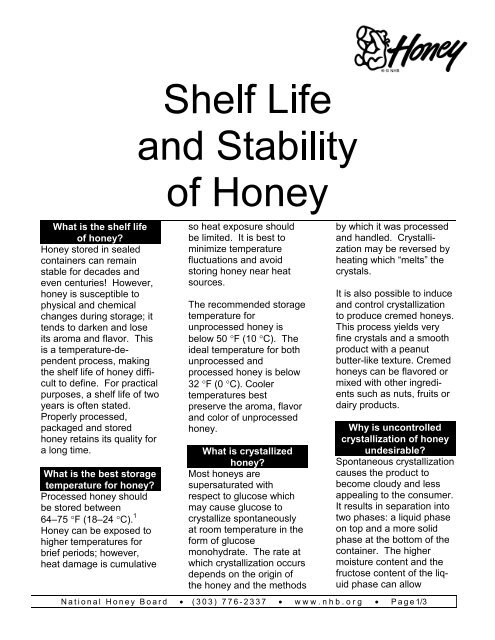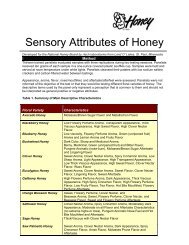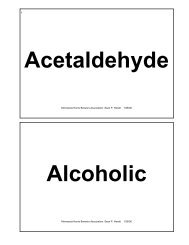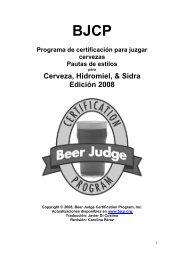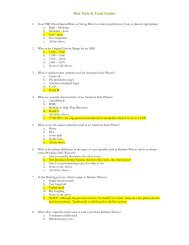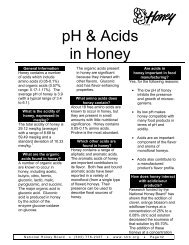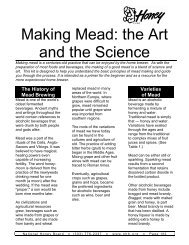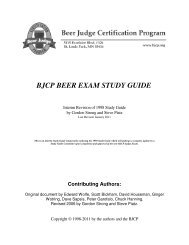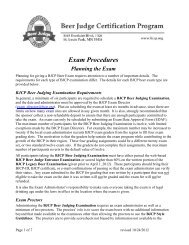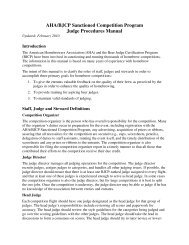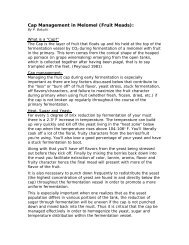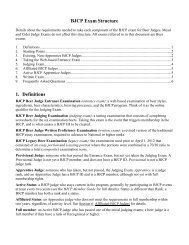What is the shelf life of honey? Honey stored in sealed ... - BJCP
What is the shelf life of honey? Honey stored in sealed ... - BJCP
What is the shelf life of honey? Honey stored in sealed ... - BJCP
Create successful ePaper yourself
Turn your PDF publications into a flip-book with our unique Google optimized e-Paper software.
<strong>What</strong> <strong>is</strong> <strong>the</strong> <strong>shelf</strong> <strong>life</strong><br />
<strong>of</strong> <strong>honey</strong><br />
<strong>Honey</strong> <strong>stored</strong> <strong>in</strong> <strong>sealed</strong><br />
conta<strong>in</strong>ers can rema<strong>in</strong><br />
stable for decades and<br />
even centuries! However,<br />
<strong>honey</strong> <strong>is</strong> susceptible to<br />
physical and chemical<br />
changes dur<strong>in</strong>g storage; it<br />
tends to darken and lose<br />
its aroma and flavor. Th<strong>is</strong><br />
<strong>is</strong> a temperature-dependent<br />
process, mak<strong>in</strong>g<br />
<strong>the</strong> <strong>shelf</strong> <strong>life</strong> <strong>of</strong> <strong>honey</strong> difficult<br />
to def<strong>in</strong>e. For practical<br />
purposes, a <strong>shelf</strong> <strong>life</strong> <strong>of</strong> two<br />
years <strong>is</strong> <strong>of</strong>ten stated.<br />
Properly processed,<br />
packaged and <strong>stored</strong><br />
<strong>honey</strong> reta<strong>in</strong>s its quality for<br />
a long time.<br />
<strong>What</strong> <strong>is</strong> <strong>the</strong> best storage<br />
temperature for <strong>honey</strong><br />
Processed <strong>honey</strong> should<br />
be <strong>stored</strong> between<br />
64–75 °F (18–24 °C). 1<br />
<strong>Honey</strong> can be exposed to<br />
higher temperatures for<br />
brief periods; however,<br />
heat damage <strong>is</strong> cumulative<br />
so heat exposure should<br />
be limited. It <strong>is</strong> best to<br />
m<strong>in</strong>imize temperature<br />
fluctuations and avoid<br />
stor<strong>in</strong>g <strong>honey</strong> near heat<br />
sources.<br />
The recommended storage<br />
temperature for<br />
unprocessed <strong>honey</strong> <strong>is</strong><br />
below 50 °F (10 °C). The<br />
ideal temperature for both<br />
unprocessed and<br />
processed <strong>honey</strong> <strong>is</strong> below<br />
32 °F (0 °C). Cooler<br />
temperatures best<br />
preserve <strong>the</strong> aroma, flavor<br />
and color <strong>of</strong> unprocessed<br />
<strong>honey</strong>.<br />
<strong>What</strong> <strong>is</strong> crystallized<br />
<strong>honey</strong><br />
Most <strong>honey</strong>s are<br />
supersaturated with<br />
respect to glucose which<br />
may cause glucose to<br />
crystallize spontaneously<br />
at room temperature <strong>in</strong> <strong>the</strong><br />
form <strong>of</strong> glucose<br />
monohydrate. The rate at<br />
which crystallization occurs<br />
depends on <strong>the</strong> orig<strong>in</strong> <strong>of</strong><br />
<strong>the</strong> <strong>honey</strong> and <strong>the</strong> methods<br />
by which it was processed<br />
and handled. Crystallization<br />
may be reversed by<br />
heat<strong>in</strong>g which “melts” <strong>the</strong><br />
crystals.<br />
It <strong>is</strong> also possible to <strong>in</strong>duce<br />
and control crystallization<br />
to produce cremed <strong>honey</strong>s.<br />
Th<strong>is</strong> process yields very<br />
f<strong>in</strong>e crystals and a smooth<br />
product with a peanut<br />
butter-like texture. Cremed<br />
<strong>honey</strong>s can be flavored or<br />
mixed with o<strong>the</strong>r <strong>in</strong>gredients<br />
such as nuts, fruits or<br />
dairy products.<br />
Why <strong>is</strong> uncontrolled<br />
crystallization <strong>of</strong> <strong>honey</strong><br />
undesirable<br />
Spontaneous crystallization<br />
causes <strong>the</strong> product to<br />
become cloudy and less<br />
appeal<strong>in</strong>g to <strong>the</strong> consumer.<br />
It results <strong>in</strong> separation <strong>in</strong>to<br />
two phases: a liquid phase<br />
on top and a more solid<br />
phase at <strong>the</strong> bottom <strong>of</strong> <strong>the</strong><br />
conta<strong>in</strong>er. The higher<br />
mo<strong>is</strong>ture content and <strong>the</strong><br />
fructose content <strong>of</strong> <strong>the</strong> liquid<br />
phase can allow<br />
National <strong>Honey</strong> Board • (303) 776-2337 • www.nhb.org • Page1/3
naturally occurr<strong>in</strong>g<br />
osmophilic yeasts to multiply<br />
and ferment <strong>the</strong> <strong>honey</strong>.<br />
Pasteurized <strong>honey</strong> <strong>in</strong><br />
<strong>sealed</strong> conta<strong>in</strong>ers may<br />
crystallize but <strong>is</strong> generally<br />
not liable to ferment.<br />
Is <strong>honey</strong>’s composition<br />
related to crystallization<br />
A number <strong>of</strong> researchers<br />
have attempted to predict<br />
<strong>the</strong> tendency <strong>of</strong> <strong>honey</strong> to<br />
crystallize us<strong>in</strong>g ratios <strong>in</strong>volv<strong>in</strong>g<br />
<strong>the</strong> composition <strong>of</strong><br />
<strong>honey</strong> with respect to<br />
glucose. A <strong>honey</strong> with a<br />
glucose/water ratio < 1.7<br />
tends to rema<strong>in</strong> liquid for a<br />
long time, while one with a<br />
ratio > 2.1 usually<br />
crystallizes quickly. 2 It has<br />
been observed that <strong>honey</strong>s<br />
with a high percentage <strong>of</strong><br />
fructose rema<strong>in</strong> liquid for a<br />
long time. Thus o<strong>the</strong>r<br />
ratios such as<br />
fructose/glucose and<br />
(glucose m<strong>in</strong>us<br />
water)/fructose have been<br />
proposed. 3 The use <strong>of</strong><br />
<strong>the</strong>se ratios to predict<br />
crystallization <strong>is</strong> possible<br />
only when compar<strong>in</strong>g <strong>honey</strong>s<br />
which differ<br />
significantly <strong>in</strong> sugar<br />
composition.<br />
Which physicochemical<br />
factors <strong>in</strong>fluence<br />
crystallization and<br />
fermentation<br />
Crystallization <strong>of</strong> <strong>honey</strong> <strong>is</strong><br />
most rapid at 52–59 °F<br />
(11–15 °C). Some preventative<br />
measures may be<br />
taken, <strong>in</strong>clud<strong>in</strong>g:<br />
•=<br />
•=<br />
Stor<strong>in</strong>g at temperatures<br />
which delay<br />
crystallization (<br />
17.1% depends on its microbial<br />
content. 6 Pasteurized<br />
<strong>honey</strong> (available<br />
commercially) generally<br />
does not ferment because<br />
<strong>the</strong> microbial content has<br />
been reduced.<br />
Is <strong>honey</strong> usually stable<br />
<strong>Honey</strong> <strong>is</strong> highly stable<br />
aga<strong>in</strong>st microbial growth<br />
because <strong>of</strong> its low water<br />
activity, low mo<strong>is</strong>ture content,<br />
low pH, and<br />
antimicrobial constituents.<br />
<strong>What</strong> <strong>is</strong> done by<br />
processors to reduce <strong>the</strong><br />
r<strong>is</strong>k <strong>of</strong> unwanted<br />
crystallization<br />
Dur<strong>in</strong>g process<strong>in</strong>g, several<br />
steps are taken to prolong<br />
<strong>the</strong> liquid state <strong>of</strong> <strong>honey</strong>.<br />
Pasteurization delays <strong>the</strong><br />
process <strong>of</strong> crystallization<br />
by d<strong>is</strong>solv<strong>in</strong>g any crystals<br />
that may be present <strong>in</strong> <strong>the</strong><br />
crude product. Pasteurization<br />
also affects<br />
yeast cells which<br />
considerably reduces <strong>the</strong><br />
possibility <strong>of</strong> fermentation.<br />
Recommended<br />
pasteurization treatments<br />
<strong>in</strong>clude flash pasteurization<br />
(170 °F for a few seconds)<br />
or heat<strong>in</strong>g at 145 °F for 30<br />
m<strong>in</strong>utes.<br />
Filter<strong>in</strong>g under pressure<br />
enhances <strong>the</strong> clear brilliant<br />
color <strong>of</strong> <strong>honey</strong> and removes<br />
some potential<br />
crystallization nuclei such<br />
as und<strong>is</strong>solved glucose<br />
crystals, air bubbles, pollen<br />
gra<strong>in</strong>s or any o<strong>the</strong>r large<br />
particles.<br />
The fill<strong>in</strong>g temperature <strong>of</strong><br />
bottles and o<strong>the</strong>r <strong>honey</strong><br />
conta<strong>in</strong>ers has an impact<br />
on crystallization as well.<br />
<strong>Honey</strong> bottled at<br />
temperatures <strong>of</strong> 104 °F<br />
(40 °C) or higher (up to<br />
130-140 °F, 55-60 °C)<br />
crystallizes significantly<br />
more slowly. 7<br />
National <strong>Honey</strong> Board • (303) 776-2337 • www.nhb.org • Page2/3
Is <strong>the</strong> conta<strong>in</strong>er <strong>in</strong> which<br />
<strong>honey</strong> <strong>is</strong> <strong>stored</strong><br />
important<br />
Some researchers have<br />
demonstrated that <strong>honey</strong><br />
<strong>stored</strong> <strong>in</strong> low density<br />
polyethylene conta<strong>in</strong>ers<br />
can lose mo<strong>is</strong>ture over<br />
time. 8 Th<strong>is</strong> loss <strong>of</strong><br />
mo<strong>is</strong>ture could contribute<br />
to crystallization.<br />
It <strong>is</strong> important to store<br />
<strong>honey</strong> <strong>in</strong> air-tight<br />
conta<strong>in</strong>ers. Th<strong>is</strong> protects it<br />
from external mo<strong>is</strong>ture<br />
which <strong>the</strong> <strong>honey</strong> may<br />
absorb. Properly sanitized<br />
and <strong>sealed</strong> sta<strong>in</strong>less steel<br />
drums <strong>in</strong> good condition<br />
are perfect for extended<br />
storage <strong>of</strong> large quantities<br />
<strong>of</strong> <strong>honey</strong>.<br />
References<br />
1 White, J.W. Jr. 1978. <strong>Honey</strong>. In<br />
"Advances <strong>in</strong> Food Research," ed.<br />
C.O. Chichester, E.M. Mrak & G.F.<br />
Stewart. 24:288-374. Academic<br />
Press, New York.<br />
2 Doner, L.W. 1977. The Sugars <strong>of</strong><br />
<strong>Honey</strong> - A Review. Journal <strong>of</strong> <strong>the</strong><br />
Science <strong>of</strong> Food and Agriculture<br />
28:443.<br />
3 Crane, E. 1975. “<strong>Honey</strong>: A<br />
Comprehensive Survey.”<br />
He<strong>in</strong>emann, London.<br />
4 Jiménez, M. et al. 1994. Influence<br />
<strong>of</strong> <strong>the</strong> Storage Conditions on Some<br />
Physicochemical and Mycological<br />
Parameters <strong>of</strong> <strong>Honey</strong>. Journal <strong>of</strong> <strong>the</strong><br />
Science <strong>of</strong> Food and Agriculture<br />
64(1):67-74.<br />
5 White, J.W. Jr. 1975. Physical<br />
Character<strong>is</strong>tics <strong>of</strong> <strong>Honey</strong>. In:<br />
“<strong>Honey</strong>: A Comprehensive Survey.”<br />
ed. Crane E., pp. 157-206.<br />
He<strong>in</strong>emann, London.<br />
6 Sanz, S. et al. 1995. Fermentation<br />
Problem <strong>in</strong> Span<strong>is</strong>h North-Coast<br />
<strong>Honey</strong>. Journal <strong>of</strong> Food Protection<br />
58(5):515.<br />
7 Assil, H.I. et al. 1991. Crystal<br />
Control <strong>in</strong> Processed Liquid <strong>Honey</strong>.<br />
Journal <strong>of</strong> Food Science<br />
56(4):1034.<br />
8 ibid.<br />
National <strong>Honey</strong> Board • (303) 776-2337 • www.nhb.org • Page3/3


